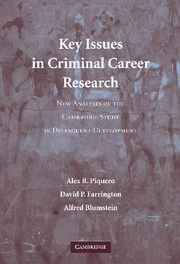 Key Issues in Criminal Career Research
Key Issues in Criminal Career Research Published online by Cambridge University Press: 30 July 2009
Is there such a thing as a “chronic” offender – one whose frequent involvement in criminal activity is marked by serious offenses? The starting point for this question must be Wolfgang et al.'s (1972) finding that 6 percent of the 1945 Philadelphia Birth Cohort was responsible for over 50 percent of the criminal acts to age 17. Perhaps no finding in criminology is better known by students and scholars alike (Laub, 2004), while at the same time being hailed by policy makers and practitioners as central to crime reduction efforts (see Schumacher and Kurz, 1999). If only it were so easy to identify such individuals ahead of time (Blumstein et al., 1985; Gottfredson and Hirschi, 1990).
The concept of chronicity was first established by Wolfgang and colleagues and applied to offenders committing five or more offenses prior to age 18. The concept – and its operationalization – however, is ambiguous because of its arbitrary designation and truncation problems. We believe that chronicity is better discussed with regard to the various relevant constituent dimensions that can vary with age, like frequency and seriousness. The basic theme is that the number of offenses committed (and the opportunity for a larger number goes up with age) and the rate of offending may vary with age.
In this chapter, we examine how chronicity is related to seriousness of offending with age. We attempt to unpack the meaning of chronicity by linking frequency, seriousness, and duration of offending.
To save this book to your Kindle, first ensure [email protected] is added to your Approved Personal Document E-mail List under your Personal Document Settings on the Manage Your Content and Devices page of your Amazon account. Then enter the ‘name’ part of your Kindle email address below. Find out more about saving to your Kindle.
Note you can select to save to either the @free.kindle.com or @kindle.com variations. ‘@free.kindle.com’ emails are free but can only be saved to your device when it is connected to wi-fi. ‘@kindle.com’ emails can be delivered even when you are not connected to wi-fi, but note that service fees apply.
Find out more about the Kindle Personal Document Service.
To save content items to your account, please confirm that you agree to abide by our usage policies. If this is the first time you use this feature, you will be asked to authorise Cambridge Core to connect with your account. Find out more about saving content to Dropbox.
To save content items to your account, please confirm that you agree to abide by our usage policies. If this is the first time you use this feature, you will be asked to authorise Cambridge Core to connect with your account. Find out more about saving content to Google Drive.